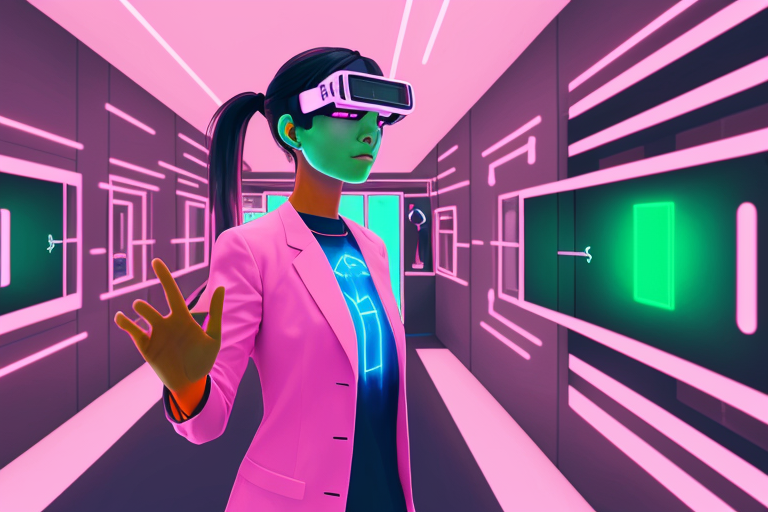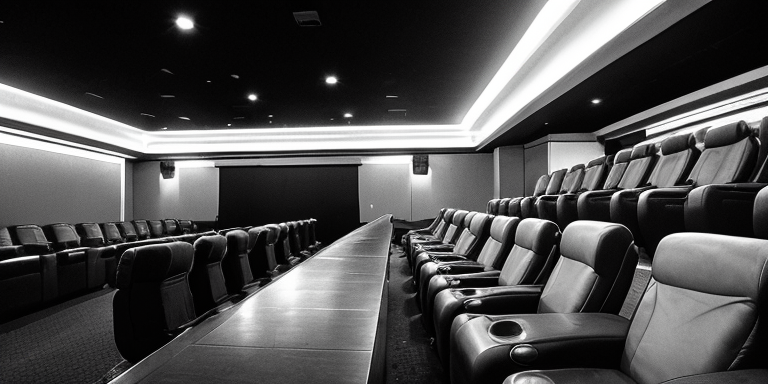Augmented Reality in E-commerce: Enhancing the Shopping Experience
In recent years, augmented reality (AR) has become increasingly popular in the e-commerce industry. AR technology allows consumers to visualize products in a more interactive and immersive way, leading to a more engaging shopping experience. AR is a technology that overlays digital information onto the real world, creating a blended experience that enhances the user’s perception of reality.
AR has the potential to revolutionize the way we shop online, making it easier for consumers to make informed purchase decisions. By providing a more realistic view of products, AR can help reduce the number of returns and increase customer satisfaction. In this article, we will explore how AR is transforming the e-commerce industry, the challenges it still faces, and the potential impact it could have on the retail industry and consumer behavior.
Before diving into the details, let’s take a brief overview of the article. In the next section, we will discuss how AR is transforming the way we shop online, including virtual try-ons for clothes, the use of AR for furniture shopping, and AR in the beauty industry. In section three, we will explore the challenges that AR still faces in e-commerce, including technical difficulties, logistics of integration, and accessibility issues. Section four will examine the potential impact of AR on the retail industry and consumer behavior, including changes in the shopping experience, increased sales, and the effect on traditional brick-and-mortar stores. In section five, we will discuss how businesses are leveraging AR to enhance customer experience and increase sales, including case studies of successful AR integration, the role of AR in building brand loyalty, and opportunities for personalized shopping experiences. Finally, in the conclusion, we will summarize the article and provide final thoughts on the future of AR in e-commerce.
Now that we have a clear understanding of what AR is and its importance in e-commerce, let’s delve into how AR is transforming the way we shop online.
The AR Revolution in E-Commerce
Augmented reality is transforming the way we shop online, providing customers with a more immersive and interactive experience. From virtual try-ons for clothes to 3D product visualization for furniture, AR is changing the way we evaluate and purchase products.
One of the most significant ways AR is being used in e-commerce is through virtual try-ons for clothes. Customers can now use their smartphones or tablets to see how clothes would look on them before making a purchase. This feature has been particularly popular among younger consumers, who are more likely to embrace new technologies. For example, Frankie, a 23-year-old college student, recently used AR to buy a new outfit for a job interview. She was able to see how different blouses and skirts would look on her without having to physically try them on. This saved her time and provided her with a more convenient shopping experience.
AR is also being used in the furniture industry to help customers visualize how products would look in their homes. Uvanni, a furniture brand, has integrated AR into their e-commerce platform, allowing customers to see how different pieces of furniture would look in their living rooms or bedrooms. This has helped customers make more informed purchasing decisions and reduced the number of returns due to furniture not fitting in the space.
In the beauty industry, AR is being used to help customers try on makeup virtually. By using their smartphones or tablets, customers can see how different shades of lipstick or eyeshadow would look on their faces. This feature has been particularly popular among younger customers who are looking for a more personalized shopping experience.
AR is changing the way customers evaluate products before making a purchase. Instead of relying on static images or videos, customers can now see products from different angles and in different contexts. This has made it easier for customers to judge the quality and fit of products before making a purchase. For example, Frankie recently used AR to buy a new pair of shoes. By using her smartphone, she was able to see how the shoes would look on her feet and how they would match with different outfits. This helped her make a more informed purchasing decision and reduced the likelihood of her returning the shoes.
However, AR still faces some challenges in e-commerce. One of the main challenges is technical difficulties, as AR requires significant computing power and bandwidth. Another challenge is the logistics of integrating AR into e-commerce platforms, as it requires significant investment and expertise. Finally, there are accessibility issues for some customers, as not all devices support AR technology.
Despite these challenges, businesses are addressing them by investing in AR technology and partnering with AR vendors. For example, some businesses are using cloud-based AR solutions to reduce the computing power required for AR. Others are partnering with AR vendors to integrate AR into their e-commerce platforms.
The potential impact of AR on the retail industry and consumer behavior is significant. AR is changing the shopping experience by providing customers with a more immersive and interactive experience. This has the potential to increase sales and build brand loyalty. However, it also has the potential to shift the balance of power towards online shopping and away from traditional brick-and-mortar stores.
Businesses are leveraging AR to enhance customer experience and increase sales. For example, some businesses are using AR to offer personalized shopping experiences, where customers can see how products would look on them or in their homes. Others are using AR to build brand loyalty by offering exclusive AR features or discounts.
The Hurdles of Augmented Reality in E-Commerce
While augmented reality has undoubtedly revolutionized the e-commerce industry, it is not without its challenges. As with any new technology, businesses are still grappling with the technical difficulties of integrating AR into their platforms. From the development of accurate 3D models to the implementation of AR software, there are many hurdles that companies must overcome to ensure a seamless AR experience for their customers.
Another significant challenge is the logistics of AR integration into e-commerce platforms. As AR requires a significant amount of processing power, it can be challenging to ensure that it runs smoothly on all devices. Additionally, businesses must ensure that their AR experiences are compatible with various operating systems and browsers, which can be a daunting task.
Accessibility is also a significant concern when it comes to AR in e-commerce. While many consumers have access to AR-capable devices, there are still many who do not. This can create a divide between those who can experience AR and those who cannot, potentially alienating a significant portion of a business’s customer base.
Despite these challenges, businesses are actively working to address them. Many are investing in the development of more accurate 3D models and AR software, while others are partnering with third-party companies that specialize in AR integration. Additionally, businesses are exploring alternative solutions to ensure that their AR experiences are accessible to all customers, such as offering non-AR alternatives or providing in-store AR experiences.
As businesses continue to overcome these challenges, the potential impact of AR on the retail industry and consumer behavior is becoming increasingly apparent. AR has the potential to transform the shopping experience, providing customers with a more immersive and interactive way to shop online. Additionally, businesses can leverage AR to increase sales by offering personalized shopping experiences and building brand loyalty.
However, the impact of AR on traditional brick-and-mortar stores remains to be seen. While some argue that AR will lead to a shift towards online shopping, others believe that it will enhance the in-store experience by providing customers with additional information and interactive elements.
The Future of Shopping: How AR Could Transform the Retail Industry
Augmented reality (AR) has the potential to revolutionize the way we shop online. As we discussed in previous sections, AR can be used to create virtual try-ons for clothes, allow customers to see how furniture would look in their homes, and even let shoppers test out makeup virtually. But the impact of AR on the retail industry goes far beyond just these applications. In this section, we will explore the potential impact of AR on the retail industry and consumer behavior.
One of the most significant ways that AR is changing the shopping experience is by allowing customers to try before they buy. This can lead to increased customer satisfaction and fewer returns. For example, imagine a customer named Frankie who is shopping for a new outfit online. With AR, Frankie can see how the clothes will look on her before she makes a purchase, reducing the likelihood that she will be disappointed when the clothes arrive. This can lead to increased customer loyalty and repeat business for retailers who offer AR experiences.
But AR also has the potential to increase sales for retailers. By allowing customers to see products in a more immersive way, AR can make shopping more fun and engaging. This can lead to increased impulse purchases and higher average order values. For example, a furniture retailer might use AR to create a virtual showroom where customers can see how different pieces of furniture would look in their homes. This can help customers feel more confident in their purchases and lead to increased sales for the retailer.
However, the rise of AR in e-commerce could also have a significant impact on traditional brick-and-mortar stores. As more customers turn to online shopping with AR experiences, physical stores may see a decline in foot traffic. This could lead to store closures and job losses in the retail industry. Judges may also need to consider the use of AR in cases involving e-commerce, such as disputes over virtual try-ons or the accuracy of AR-generated product images.
Despite these potential challenges, the future of AR in e-commerce looks bright. As retailers continue to experiment with AR experiences, we can expect to see even more innovative applications in the future. For example, retailers could use AR to create personalized shopping experiences for individual customers, allowing them to see how products would look specifically on their body type or in their home. This could lead to even higher levels of customer satisfaction and loyalty.
Enhancing Customer Experience and Increasing Sales with AR
Augmented reality has the potential to revolutionize the way businesses interact with their customers. By providing a more immersive and personalized shopping experience, businesses can increase customer engagement and boost sales. In this section, we will explore how businesses are leveraging AR to enhance customer experience and increase sales.
Case Studies of Successful AR Integration into E-commerce
Several businesses have successfully integrated AR into their e-commerce platforms to provide customers with a more interactive and engaging shopping experience. For example, Sephora’s Virtual Artist app allows customers to try on makeup virtually using their smartphone camera. This app has been a huge success, with over 10 million downloads and a 20% increase in conversion rates for customers who use the app.
Another example is IKEA’s Place app, which allows customers to virtually place furniture in their homes to see how it would look before making a purchase. This app has been a game-changer for IKEA, with a 2-3x increase in conversion rates for customers who use the app.
The Role of AR in Building Brand Loyalty
AR can also play a significant role in building brand loyalty. By providing customers with a unique and memorable shopping experience, businesses can create a strong emotional connection with their customers. For example, Nike’s SNKRS app uses AR to provide customers with an interactive and personalized shopping experience for limited edition sneakers. This app has helped Nike build a loyal fan base of sneaker enthusiasts who eagerly await each new release.
Opportunities for Personalized Shopping Experiences
AR also offers opportunities for personalized shopping experiences. By using AR to create virtual storefronts, businesses can provide customers with a customized shopping experience tailored to their preferences. For example, the fashion retailer H&M created a virtual storefront that allows customers to browse and purchase items based on their individual style preferences.
Future Possibilities for AR in E-commerce
The possibilities for AR in e-commerce are endless. As technology continues to evolve, businesses will be able to provide even more immersive and personalized shopping experiences for their customers. For example, AR could be used to create virtual showrooms where customers can interact with products in real-time, or to provide customers with personalized recommendations based on their individual preferences and purchase history.









